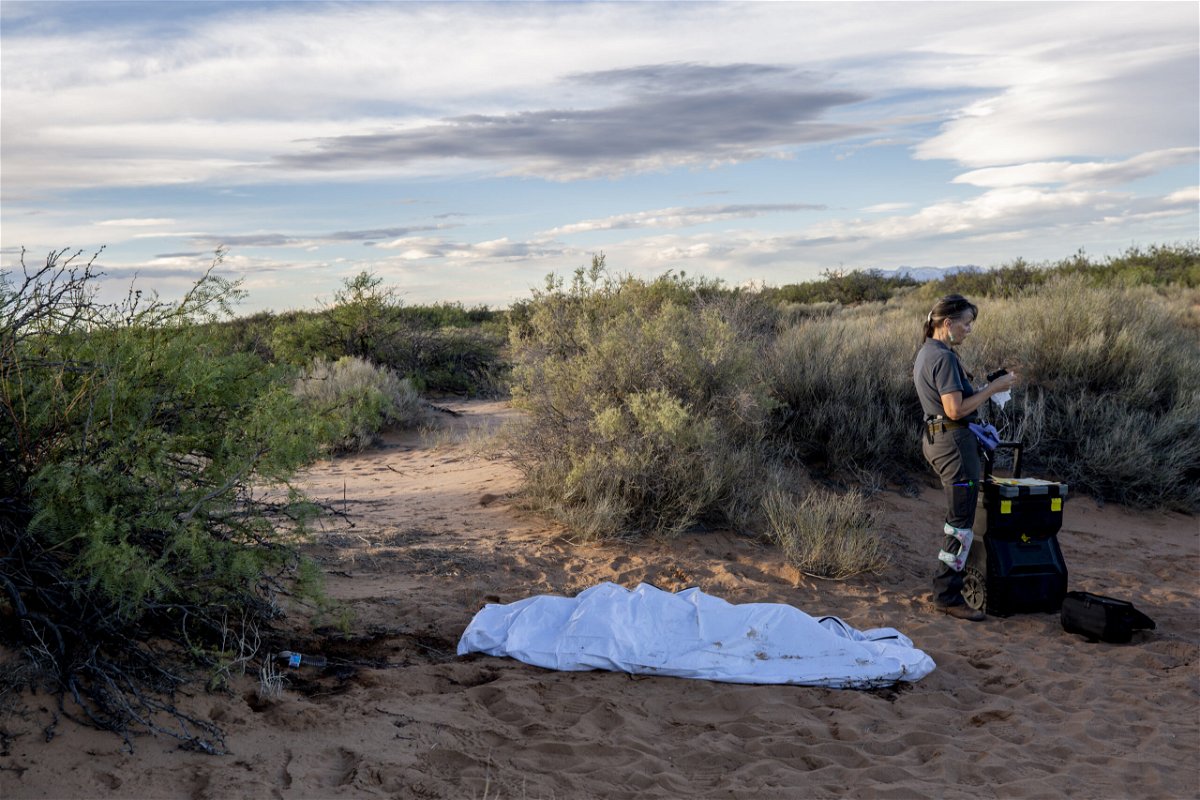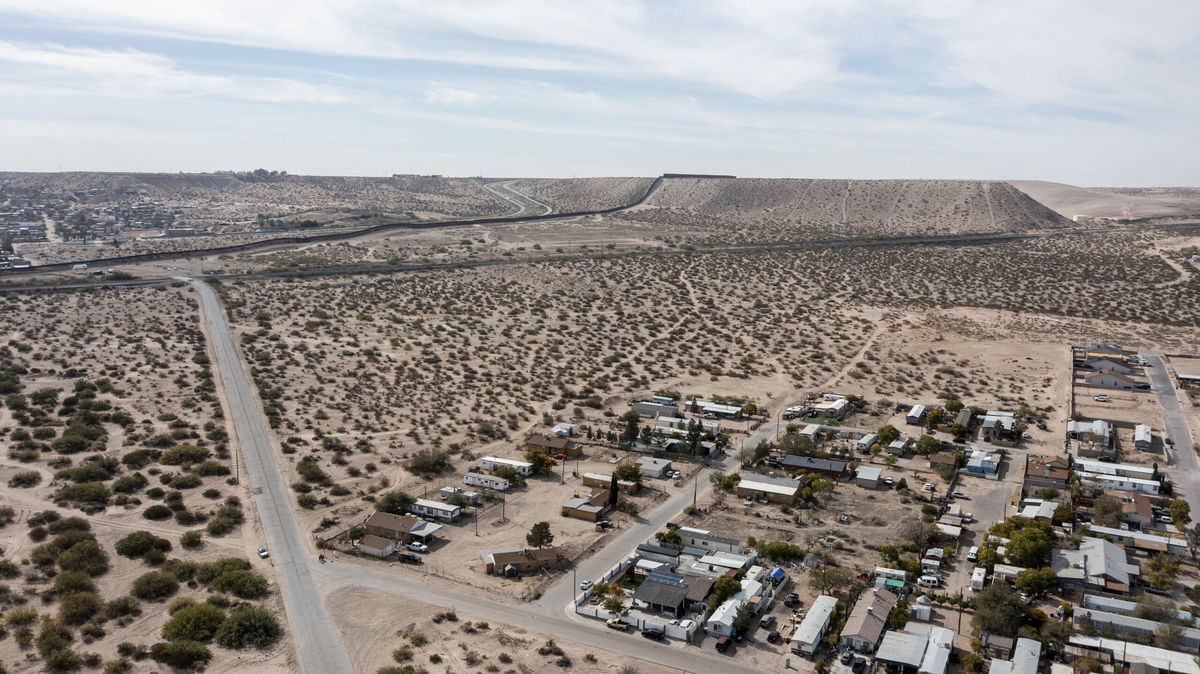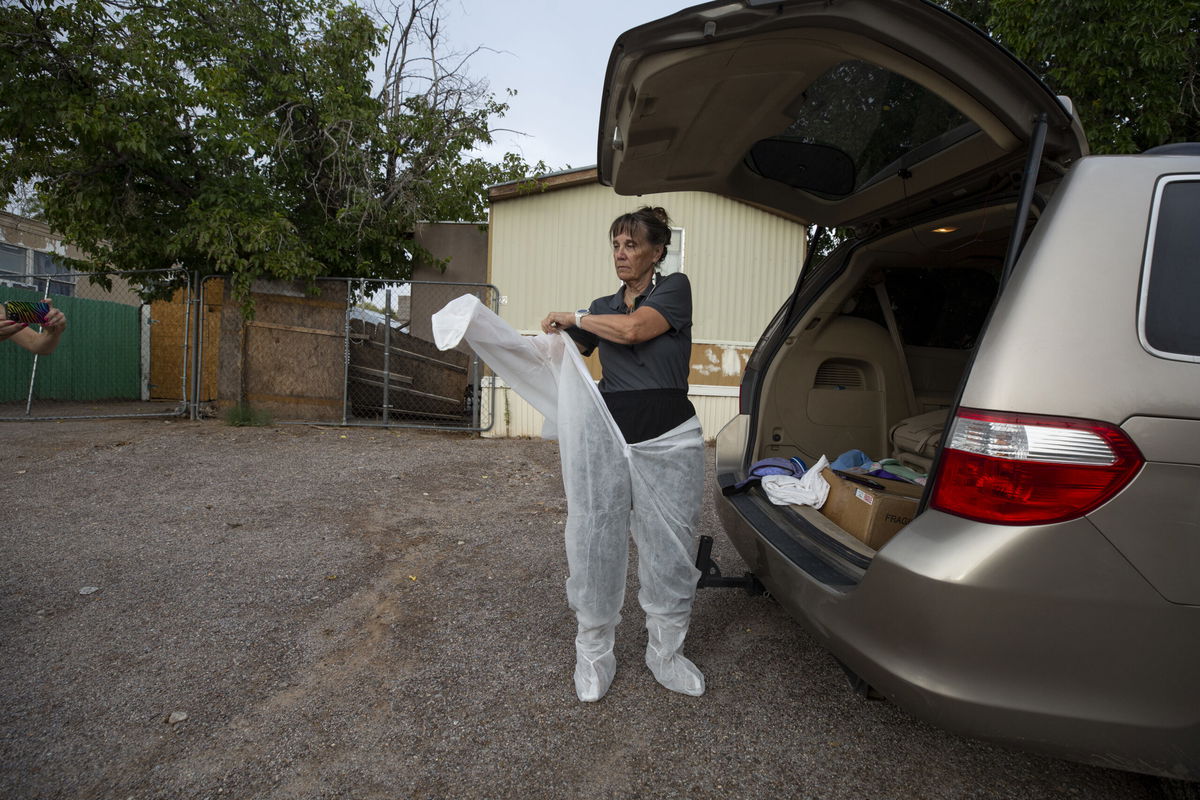‘It’s heartbreaking’: Day after day, New Mexico investigator recovers migrant remains

Lauren Villagran
El Paso Times
Editor’s note: This story contains reporting and images that some readers may find disturbing.
Laura Mae Williams knelt beside the body of a woman near the U.S.-Mexico border, her kneepads pressing into the searing sand.
The field investigator for New Mexico’s Office of the Medical Investigator read the ground temperature with an infrared thermometer: 125 degrees. She estimated the body – belonging to 31-year-old Yenefer Vazque, nationality unknown – had been there for three or four days.
Vazque and the bodies of 83 other “probable border crossers” were found in southern New Mexico in the nine months through Sept. 30, according to OMI data obtained by the El Paso Times, part of the USA TODAY Network.
That's up from 61 found in 2022. A surge in deaths of women accounted for most of the increase, doubling from last year and more than tripling from 2021. Seven bodies were so badly decomposed their gender couldn’t be identified.

The southern New Mexico desert outside El Paso claimed more migrant lives this year than any other place in Border Patrol’s El Paso Sector, where at least 149 migrants perished in a region that stretches from West Texas across New Mexico. The migrant death toll was the highest since public record-keeping began a quarter of a century ago. The number does not include migrants killed in Juárez, including the 40 killed in an immigration detention center.
Williams has responded to dozens of investigation calls this year to document “unattended deaths” in the desert.
Faced with obstacles in the Rio Grande in El Paso, where Texas Gov. Greg Abbott ordered the installation of concertina wire, migrants without access to a legal pathway moved a few miles west to the New Mexico desert – undeterred by the fatal risks of triple-digit heat and the 30-foot border fence.
Vazque died in the clothes she wore as she trekked to her hoped-for future in the United States: a black shirt and blue jeans, a black long-sleeve shirt tied around her waist, according to the Doña Ana County Sheriff's report. There were sponges tied to her white shoes to cover her tracks through the sand.
The sun, bright and dangerous, shined relentlessly as Williams worked.

She lifted Vazque's sun-blackened arm, checking for signs of trauma. She snapped photos with a pocket-size digital camera and made notes of her findings for the coroner’s autopsy.
“We investigate the death to serve the living,” Williams said. “The family wants to know, ‘Why did my person die?’”
To reach Vazque’s body, two Border Patrol agents had lifted 66-year-old Williams over a barbed-wire ranch fence where she climbed on the back of one of their all-terrain vehicles. The four-wheeler bounced into the dunes.
Wiry creosote bushes clawed at the sky. They pulled the sand into shapes that rose and fell like burial mounds.
Vazque and dozens of other women died within reach of a good Samaritan and a glass of water. She was 200 yards from New Mexico’s Highway 9, patrolled by at least half a dozen law enforcement and emergency agencies.
"They're half a mile away from a populated area, but they don't know that," said Sunland Park Fire Battalion Chief Ramiro Rios, whose agency responded to dozens of calls for medical assistance or body recovery this summer. "And so they go in circles trying to find a way out."
“They aren’t asking for help and they are within hundreds of yards of help,” said Landon Hutchens, a spokesman for U.S. Customs and Border Protection. “That is the tragic irony.”
5 cases: Police reports describe harrowing discoveries
On May 19, a child found a body behind Doña Ana Community College, a woman whose Mexican passport identified her as Marlene Leyva-Perez. She “was deceased and had been for a while,” according to the Sunland Park Police report.
On May 31, a Border Patrol agent on horseback found the remains of a young woman near a busy industrial crossroads. The phone in her fanny pack rang; a Doña Ana Sheriff's detective answered. The caller identified her as Angelica Sales-Morales, from Guatemala. A Facebook post announced her body would return to Colontenango before dawn on July 19; in a photo, she wears an embroidered blouse, hoop earrings and plum lipstick.
On June 25, three motorcyclists discovered a woman’s body in Santa Teresa, an unincorporated community beside Sunland Park, New Mexico. They asked a resident to call police. Investigators identified the woman as 35-year-old Arelis Chavez Bueno, according to the Doña Ana Sheriff’s Office report. Her nationality wasn’t recorded.
On Sept. 9, Emiliana Ruiz Juárez was still alive when a Border Patrol agent found her unconscious in a Sunland Park neighborhood and began CPR, according to a Sunland Park Police report. Firefighters “arrived on scene and intubated Emiliana, clearing her mouth from blood.” She didn't survive. Her nationality wasn’t recorded.
The police reports told the last chapter of each woman’s migration story, yet every tale ended the same. Williams or another OMI field investigator arrived and tried to identify the person, always searching for a name.
The families of Vazque, Leyva-Perez, Chavez Bueno and Ruiz Juarez were the lucky ones; their remains would be returned home.
OMI still hasn’t identified the bodies of dozens of other "probable border crossers" who died this summer. Their bodies wait in an Albuquerque morgue.

Border Patrol agents carry portable fingerprint scanners to death scenes – the quickest way to identify a person carrying no ID. But under a beating sun, fingerprints disappear as the body decomposes.
“Even though they may or may not be identifiable, we have to (try) to positively identify the person so we can get them home," Williams said. "So that we can get them to their family.”
How people die in the heat
This is how heat kills: When the air temperature is hot, over 100 degrees, the ground is hotter, as hot as 150 degrees. Heat bears down from the sky, exhales up from below.
Without shade or shelter, the body’s core temperature begins to rise.
The body reacts and starts consuming its available water to cool down. The normal human response is to search for shade or shelter and start rehydrating, said Dr. José Burgos, a physician of internal medicine and director of University Medical Center’s hospitalist program in El Paso.
But the desert surrounding El Paso offers no reprieve, where mesquite bushes and creosote mounds create a maze and obscure the short distance to help.

As the body consumes its water, the electrolytes – essential minerals that regulate muscle contractions – struggle to do their job as their medium disappears. “The muscles start breaking and that will create a catastrophe,” Burgos said.
The internal "catastrophe" happens fast in extreme conditions.
Symptoms appear as if from a list of adverse reactions on a prescription medication: weakness and pain; headaches; nausea and vomiting.
The body can’t sweat and the brain becomes confused. Shivering sets in – hyperthermia.
“It’s not the fever coming from infection but a fever produced by the elevated temperature in the environment,” Burgos said.
The organs begin to fail: kidneys, lungs, heart.
Inside an ambulance, Sunland Park firefighters attempted CPR on one person whose internal body temperature was so hot, they needed to take turns making chest compressions because their hands were burning, said Sunland Park Fire Chief Danny Medrano.
"It’s frustrating to see the human suffering that is going on," Medrano said.
Williams, too, has thought a lot about the desert deaths this year about how heat kills.
“It’s heartbreaking,” she said. “You can only begin to imagine their suffering.”
Calls to dispatch: 'My person is dying'
Williams is so well-known to area law enforcement that she shows up in police reports not as a field investigator but casually, as "Laura Mae," a testament to her three decades of experience and the number of times she has been called out to the desert in 2023.
The work, which she calls “community service,” is her retirement from a career in special education. She has worked part-time as a forensic investigator since the 1980s but has dedicated herself exclusively the past 13 years to attending to the dead.
“Maybe it’s my calling,” she said, “Many of us feel like it’s our community service. It’s something that we were somehow called upon to do and we do it.”
She keeps stacks of white Tyvek suits, made in Mexico, in the back of her tan Honda minivan. Sometimes she forgets to dispose of the used ones, and the minivan fills with the peculiar scent of the deceased, a singed sweetness that, once experienced, is hard to shake and impossible to forget.

When Sunland Park Police or the Doña Ana Sheriff's Office calls, Williams dons a gray OMI polo shirt with a silver nametag pinned at the chest. She climbs in her minivan – the middle seats removed to accommodate the supplies she needs while traveling to death scenes – and drives fast to the address.
“Because we've had so many crossers this year, this is the first time I have had many scenes where the information was somebody who cared enough about them, sometimes family, sometimes a friend, who called in and said, ‘My person is sick. My person is dying. Maybe my person has passed.’ They are calling dispatch so hopefully they can get somebody to them.”
More often than not there is no physical address.
She jots down an intersection or a highway mile marker on her notepad, the nearest location to a road where Border Patrol agents or firefighters can bring her to the body on foot on an ATV. She drags her roller bag of equipment through the sand to kneel beside the dead and document their end.
“It doesn't matter who this person might have been in life,” Williams said, describing her work. “You you treat everyone the same, no matter their socioeconomic status, race, gender. We respect everybody.”
A new box to check: ‘Probable border crosser’
Williams reports to the Office of the Medical Investigator, the state coroner's office.
Housed at the University of New Mexico in Albuquerque, OMI operates a centralized system that is different from the county-led coroner's offices in Texas and Arizona. Chief Medical Examiner Dr. Heather Jarrell manages the team of investigators who handle the field work in each of their regions.
OMI's mission is twofold, Jarrell said: to determine the cause and manner of death, and to identify the deceased.
The spike in migrant deaths at the border has taxed OMI in ways Jarrell didn't expect and couldn't have prepared for. To better track the deaths, she and her team decided this summer to create a new checkbox for "probable border crosser" on medical examiner forms.
Jarrell had never seen so many bodies in a state of such advanced decomposition that Border Patrol attempts to scan fingerprints fail. Many could go unclaimed for years.
"They would be considered a vulnerable population," she said. "They're found outdoors. And so full autopsy is our standard operating procedure in those circumstances. The identification process can be lengthy depending on the state of the remains."
When fingerprints aren't available, OMI turns to dental or radiographic records. When those methods come up short, Jarrell turns to Dr. Heather Edgar, OMI's forensic anthropologist. Edgar performs the painstaking work of investigating clues to the deceased person's country of origin or ethnicity – steps toward connecting with a consulate that could help her find family members.

"It could be years," Edgar said in a joint interview with Jarrell.
"It's not uncommon for them to carry an I.D. that is not them," Jarrell added, "but at least we have a place to start, if they have something on their person. Sometimes there is nothing, and they are true Jane Doe or John Doe, and we have no idea who they are."
A red pillow for the dead
At Vazque’s side, Williams finished her investigation and notes. She motioned for help. The deputies and border agents lifted Vazque into a white body bag and zipped it closed. Firefighters strapped her remains to an orange rescue basket and loaded the basket onto their ATV.
Williams opted to hike back out to the highway, her kneepads around her ankles.
Border Patrol agents and the sheriff's deputies drove off. Three firefighters stayed behind as Williams waited with Vazque's body on the side of the road.

She finished her notes and tossed her kneepads into her minivan. She wondered, as she often did: Would the family ever learn what happened to their person?
The funeral home van arrived. The men lifted Vazque, in the body bag, onto a stretcher.
Carefully, they rested her head on a red pillow.
